 While seven years of consecutive sales growth in the North American automotive industry have put vehicle handling ports to the test in terms of throughput, many of them are now being tested further by the slowdown in sales in the US, with inventory build-ups in some ports, and slower throughput.
While seven years of consecutive sales growth in the North American automotive industry have put vehicle handling ports to the test in terms of throughput, many of them are now being tested further by the slowdown in sales in the US, with inventory build-ups in some ports, and slower throughput.
Meanwhile, others are dealing with increases, whether from traditional import sources such as Germany or Japan, or short-sea imports from Mexico.
[in_this_story align="right" border="yes"]Overall, the outlook for vehicle handling at North American ports this year is down on what it has been over the past five years, part of a reversal that began in 2016. Out of the 30 ports that submitted data in our annual survey, there was overall handling of 7.06m new passenger vehicles, around a 2% drop on 2015. Almost two thirds of that figure was made up of imports (5.26m, which declined by 1%), while exports – hurt by a strong dollar and troubles in destination markets like the Middle East – saw a sharper fall of 4%.
US sales, which hit 17.5m last year, are expected to stagnate over the coming years. They dropped 1.4% in the first quarter of this year, and could go as low as 16.3m over the coming years to 2019, according to figures from PwC Autofacts, before recovering to around 2016 levels. Mexican sales, meanwhile, stood at a record 1.6m in 2016, and in Canada they also hit a record 1.95m; while those numbers may grow, they will not do much to increase overall sales numbers in the region.
Despite the drop, managing capacity at car terminals continues to be a big concern. A number of ports are struggling to store inventory, in part because the slowdown in sales for smaller cars and sedans has been worse than anticipated. Some terminals are being used as storage yards, with bigger inventories hurting efficiency. That is at least in part because dealers are unable or unwilling to overstock their facilities, leaving the vehicles at the ports. The build-up of inventory is also a result of bigger post-Panamax vessels delivering greater volumes of cars to them, adding to the congestion.
Growth in Mexico has also led to problems in capacity and throughput, especially at Veracruz, which was the continent’s largest vehicle-handling port for the sixth time in seven years, as well as southern US ports, though the effect is being felt elsewhere, too. Expensive real estate costs in the north-east as well as on the US west coast also constrain potential growth.
Nevertheless, many ports continue to invest in land and infrastructure to cope with space issues and handle pockets of sustained growth.
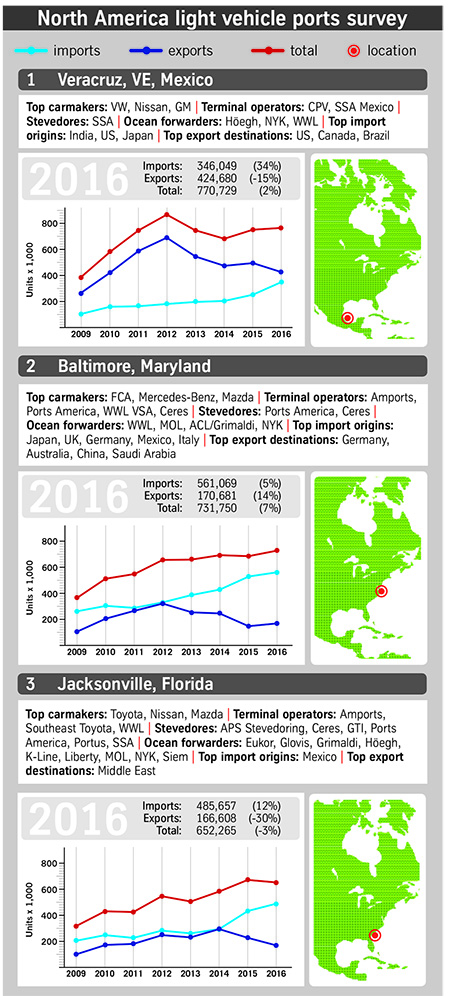 Those continuing to invest do so despite uncertainty regarding the trade policy of the Trump administration, including an upcoming renegotiation of Nafta, as well as threats to levy extra duties and taxes on imports from countries such as Germany, South Korea and Japan – which together make up the overwhelming majority of volume imported to most major US vehicle-handling ports.
Those continuing to invest do so despite uncertainty regarding the trade policy of the Trump administration, including an upcoming renegotiation of Nafta, as well as threats to levy extra duties and taxes on imports from countries such as Germany, South Korea and Japan – which together make up the overwhelming majority of volume imported to most major US vehicle-handling ports.
Donald Trump’s protectionism could have multiple effects. Even without knowing the outcome on tariffs and trade, doubts over Nafta could dissuade investors from putting money into Mexican projects, including much-needed rail capacity and port space.
In Canada, which benefits from open Nafta trade for vehicle imports and exports with the US and Mexico, officials at the port of Vancouver, the country’s largest for vehicles, are worried about the knock-on effects on changing trade policy.
“The port of Vancouver remains primarily focused as the gateway for automakers looking to supply new vehicles for sale in the Canadian market,” says a spokesperson for the port. “The strength and direction of that business may depend largely on developments in foreign trade relations and possible changes to trade agreements.”
Fortunately, such concerns have not entirely dissuaded investors in North American markets. In Mexico, for example, terminal operators and shipping lines are looking at potential trade not only within Nafta, but also with Europe and Asia. Vehicle processor SSA Mexico, which has operations at four Mexican ports, expects to handle about 922,500 vehicles at the country’s ports this year, a 50% rise, and largely thanks to a new terminal at Lázaro Cárdenas, according to Bill Kerrigan vice-president of logistics at the company.
New global trade lanes also look set to develop. Volvo Cars and General Motors started in recent years to import some vehicles from their plants in China to the US market, albeit in [sta_anchor id="1"]relatively small numbers. However, Ford’s recent announcement that it will import the Focus to North America mostly from China starting in 2018 – cancelling earlier plans to build it in Mexico – could signal a significant new shipping flow. Around 170,000 Focus models were sold in the US alone in 2016. Ports and shipping lines will be taking note.
Concerns about congestionToday, there are still many questions over space and connections in Mexico and a number of US ports, which the sales slowdown is actually making worse.
American Honda is just one carmaker concerned about capacity. It exported more than 48,700 vehicles out of the Mexican ports of Veracruz and Lázaro Cárdenas last year, and uses seven ports in the US that together handled 69,500 exports over the period. Charles Franklin, manager of export logistics, said its outlook for vehicle flows at the ports this year and beyond shows continued and increased congestion, especially on the US east coast and in Mexico, which is also hampered by rail infrastructure challenges and a limited availability of trucks.
“We have encountered an increase in vessel schedule inconsistency and missed vehicle port calls,” says Franklin. “Additionally, with the congestion at the ports, some processors are challenged to meet processing demands prior to vessel departures.”
Rising inventory at ports is also contributing to the problem. “A number of OEMs are using ports for storage,” adds Franklin. “[But] shipping ports are designed for the kinetic movement of vehicles. Additionally OEMs are doing increased services at the ports, adding to space constraints and slowing the flow through them.”
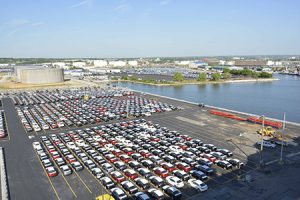
Richard Heintzelman, executive vice-president of WWL America, also notes that the recent contraction of the vehicle sales rate has triggered a growing inventory of automotive units across ports in North America. He points to a “slight uptick in storage”, which should be monitored as it could have a negative effect and create congestion.
“This tends to vary by OEM and port, but storage does consume land and this can be a challenge,” says Heintzelman. “Like all products moving throughout the global supply chain, the name of the game is velocity and speed to market.”
Some operators note that limited space is holding back growth. This is the case at Veracruz and elsewhere in Mexico. But it is also true at Los Angeles, which increased volume by 21% in 2016, but is unlikely to be able to exceed that now.
“With 200,000 units we have reached the limit during peak import volume,” says Marcel van Dijk, manager of cargo marketing at the port, adding that space constraints have been the main challenge over the last year. “We cannot expand the terminal, so this volume will be maintained for the next 3-5 years.”
He continues: “What is further limiting the port is the fact that the US headquarters [of the OEMs] and dealers are pushing inventory toward the terminal. So we become a holding facility, instead of a throughput facility.”
WWL, the only tenant at the port, handling mostly Nissan vehicles, is currently working on a 37-hectare site. However, with model year changes and upcoming seasonal factory shutdowns, OEMs are pushing volumes at the terminal.
Those at the car-handling terminals at the nearby Long Beach are also feeling the strain because of competition for land between automotive customers, container distribution sites and e-commerce fulfilment centres.
Real estate is an issue elsewhere on the west coast. At Vancouver, Canada, there is not much room left and providing more marine terminal land is difficult given the pressures of the local market, according to a spokesperson for the terminal. That said, there have been upgrades to the berths at the vehicle-handling terminal run by WWL at Annacis Island, completed in March this year.
With port space constraints in many locations, many would be keen to see details of the $1 trillion infrastructure plan that the Trump administration has promised over the next decade. Elaine Chao, the transportation secretary, has said that more details will be unveiled later this year.
What seems clearer from the 2018 budget request Trump sent to Congress in May, however, is that federally funded port projects are set to decline. The administration’s ‘Infrastructure Week’ in June also made it clear that the administration expects much future infrastructure investment to come through the private sector.
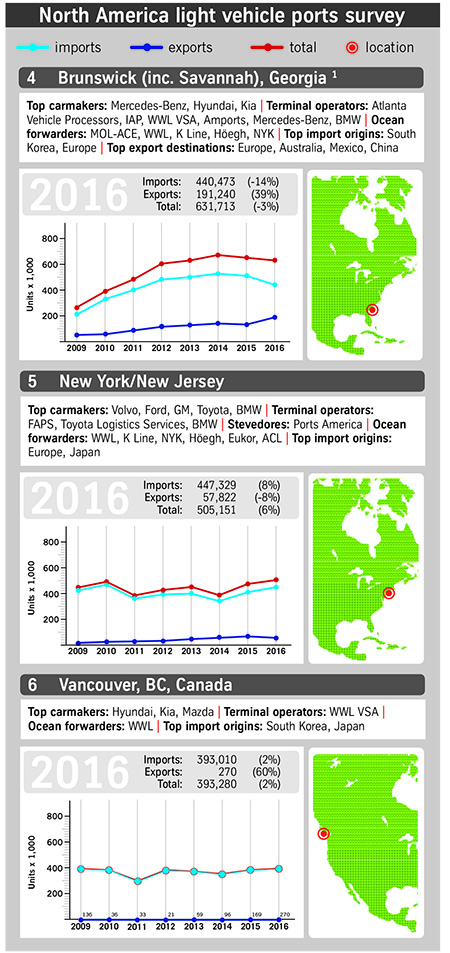 According to Kurt Nagle, president and chief executive of the American Association of Port Authorities, the association is “encouraged by the prospect of a sizable infrastructure investment programme being considered”, but it is simultaneously concerned about significant reductions proposed for fiscal 2018 in many of the programmes critically [sta_anchor id="2"]important to ports. Those included TIGER (Transportation Investment Generating Economic Recovery) and the HMTF (Harbor Maintenance Trust Fund), along with discretionary grants, both of which have supported projects and funding for vehicle-handling terminals and ports in the US.
According to Kurt Nagle, president and chief executive of the American Association of Port Authorities, the association is “encouraged by the prospect of a sizable infrastructure investment programme being considered”, but it is simultaneously concerned about significant reductions proposed for fiscal 2018 in many of the programmes critically [sta_anchor id="2"]important to ports. Those included TIGER (Transportation Investment Generating Economic Recovery) and the HMTF (Harbor Maintenance Trust Fund), along with discretionary grants, both of which have supported projects and funding for vehicle-handling terminals and ports in the US.
Mexico – promise and uncertaintyMexico remains a hot topic for terminal operators and shipping lines because of its strong production and export growth in recent years. Shipping within North America from Mexico has undoubtedly increased, especially for some US east coast ports. The growth of the local market in recent years has also been driving up ocean imports to Mexico, which grew by 13% in 2016 to nearly 610,000. That is only about 90,000 fewer than the number of vehicles it exports and, in fact, that rise in imports has actually compensated for a decline in exports from Mexican ports in 2016.
Meanwhile, figures from Kansas City Southern, a class one railway with a division in Mexico, reveal that short-sea vehicle exports to the US out of Mexico currently make up only around 10% of exports, compared to 90% for rail.
In many ways, it would therefore seem as though Mexican ports are simply not capturing the growth of exports to the US and Canada that they might expect to – at least, not yet.
There are a number of reasons for this, including an integrated rail network between Mexico and North America that is hard to beat when it comes to serving certain regions of the US. The disparity between rail and short-sea is further compounded by inconvenient shipping and lead times from Mexico to the US, as well as congestion and poor productivity in many Mexican ports.
For one thing, trade between the US and Mexico remains unbalanced, with relatively few cars travelling from the US by ship into Mexico. That means shipping lines build their services as part of global trade loops to serve the US and Mexico, rather than dedicated shuttles or short-sea vessels, as is common in Europe.
“The reality is that services out of Mexico are seen by the customer base as a short-sea trade, but it is essentially supported by deep-sea vessels and has transit times which are fairly close to a trans-Atlantic crossing,” says WWL’s executive vice-president, Flavio Batista. “This then triggers a cost base [for short-sea] that is more in line with deep-sea operations.”
The infrastructure deficit at Mexican ports is also a major factor in dissuading OEMs from turning to short-sea shipping. For example, Veracruz saw its growth slowed by outdated infrastructure and available capacity, according to Bill Kerrigan at SSA Mexico.
Kerrigan says Veracruz, is “filled to the brim and worse during the push months”. Uneven plant releases, vessel scheduling and multimodal coordination continue to be challenges for flows in and out of Mexico.
Poor inland connections also put off customers. Kerrigan points to one OEM that had recently shifted exports from Veracruz to a west coast port for shipments of vehicles to the US east coast. While that appears contradictory, Mexican rail to Veracruz is still plagued with delays and vandalism, and the OEM is trading off transit days for quality. Veracruz’s congestion, with ro-ro vessels queuing to dock, is also driving away some OEMs.
Furthermore, Veracruz and other Mexican ports suffer from ineffective planning and coordination, say experts. Honda’s Franklin says that although ports are interdependent on each other, there is little or no communication between them.
“If one port is backed up, it affects US, Mexico and non-continental ports, considering most vessels travel in circles,” he says. “Most information to the ports comes from the vessel companies and some from OEMs or other transportation providers.”
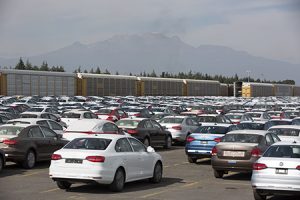 Mexican ports have experienced capacity issues as a result of production growth and a huge rise in imports
Mexican ports have experienced capacity issues as a result of production growth and a huge rise in importsBetter communication between the ports is needed and Franklin says an inventory database, similar to the travel industry’s global distribution system, could ease the problems the sector is now facing.
He adds that improvements in the short-to-medium term should include port access for multiple rail carriers at Veracruz as well as more and better trucking routes throughout the country. He also points to more than 30 rail projects across the country that would help alleviate bottlenecks.
Rising starsDespite Mexico’s problems, its port network is gaining more attention and investment. On the west coast, Lázaro Cárdenas is expected to grow following last year’s contract for SSA Mexico to operate a car terminal there. The company is investing $56m as part of a first phase of development there that will see construction of an initial 80,000 sq.m site. It has been signed for 30 years and the operation will eventually cover an area of around 420,000 sq.m on Cayacal Island.
The facility is initially expected to handle up to 400,000 units annually, with a second phase of development potentially expanding that to 750,000 units. Kerrigan said there would be “double digit” increases at the port as a result of its investment. SSA already expects to handle 245,000 units at the port this year.
Other ports are also seeing new business. Altamira, on the Gulf coast, saw a huge spike last year because of Kia export volumes, shipped via the port from its new plant in Monterrey. Exports for the year were just short of 112,000 – already a 45.5% rise – but looking at the monthly figures shows a fast increase in handling. In January 2016, Altamira handled just under 2,000 vehicles for export. In June it handled 10,000 cars and by December the figure was around 16,800.
Charles Franklin from Honda says that rail access to Altamira from the south will improve throughput in the short-to-medium term.
While its vehicle handling is more modest, Mexico’s Mazatlan port also saw a sizeable jump, handling around 54,200 units last year, mainly imports, which was a fivefold increase on 2015 (although the port only returned to vehicle handling in October of that year following a five-year hiatus). Nissan and Ford are using the port.
Manzanillo Terminal Company (CTM), which belongs to the Gume Group, has also just been given a contract to operate a general cargo terminal in the port of Manzanillo. The concession, issued by the port authority, covers the operation of a common-user facility given over to all types of cargo handling, including finished vehicles.
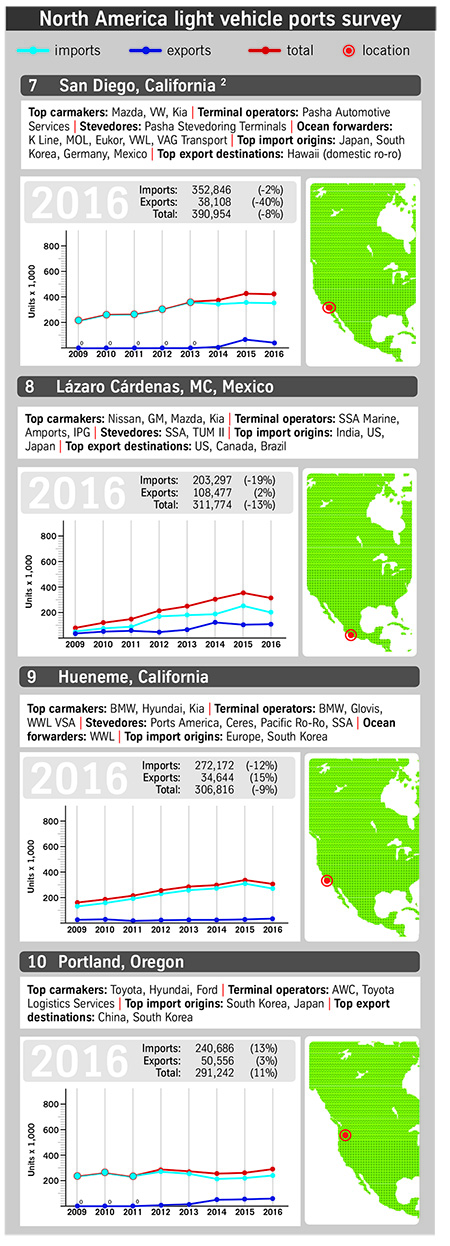 [sta_anchor id="3"]There are even cars now being moved out of Tuxpan port on Mexico’s east coast. Mazda is using the site as an alternative to Veracruz for vehicle shipments to the US, though the vehicles have to be delivered by truck from the carmaker’s Salamanca plant because there is no rail link.
[sta_anchor id="3"]There are even cars now being moved out of Tuxpan port on Mexico’s east coast. Mazda is using the site as an alternative to Veracruz for vehicle shipments to the US, though the vehicles have to be delivered by truck from the carmaker’s Salamanca plant because there is no rail link.
Protectionism versus opennessFears remain over what the Trump administration will do about tariffs on cars made in Mexico and elsewhere, though the threat of a 35% import tax on a number of carmakers has not yet come to pass. Still, with 80% of the vehicles made in Mexico exported – and almost 90% of those going to the US and Canada – the threat of a reduction in supply north of the border could be very damaging.
In January, for example, Ford pulled out of its plan to build a $1.6 billion assembly plant in San Luis Potosi, though it said that decision was down to the problem of slowing demand for the smaller vehicles. Ford’s more recent plans to build the Focus in China rather than its Hermosillo plant is another blow to Mexico.
However, Mexico is widening its trade and dealing with more foreign OEMs outside of the US, including in Asia, from which it is getting a growing number of imports. Mexico and the EU are also set to update their trade agreement, which allows for tariff-free trade for vehicles.
Altogether, Mexico has free trade agreements covering 45 countries. Earlier this year, BMW said it would stick with plans to build a plant in San Luis Potosi, regardless of what might happen with Nafta, citing the potential to adjust Mexican exports in its global systems.
“While Mexico is certainly an important part of Nafta, it has become an increasingly important component of many of the OEMs’ global production platforms, serving [sta_anchor id="4"]markets throughout the world,” said WWL’s Flavio Batista. “This is another reason why port infrastructure needs improvement, as while rail service may carry the majority of the Nafta volumes, more global export volumes require deep-sea ocean services with robust port capability.”
East coast – not so easy feelingThe north-east of the US, the largest vehicle-handling region across North America, saw solid growth in 2016, led by strong volumes at its largest ports, Baltimore and New York/New Jersey. However, being in the most densely populated part of the country, ports in the north-east often struggle with congestion and clogged inland links.
The port of Baltimore was once again the second busiest car-handling port in North America and, for the sixth year, the busiest within the US. It saw almost 7% growth on last year overall to 731,750 vehicles. A spokesperson says that it expects to handle about the same this year, and in the first quarter of 2017 it handled 195,000 vehicles.
The port increased imports by around 5% to more than 561,000 units, with large volumes from Japan, the UK, Germany and Italy. Exports were up almost 14% on 2015, with Germany, Australia, China and Saudi Arabia the top export destinations. The port is also sending vehicles to Mexico, a trade that a spokesperson says has been doing “very well” for the port’s short-sea business.
Baltimore is faced by its own occasional strains on capacity; a spokesperson admits that it is always looking for land to grow its automotive business, but the port does have overflow lots and is supported by the local authority, which has helped it to manage high levels of inventory.
“The Maryland Port Administration is always aggressive when it comes to improving infrastructure for its commodities,” says a spokesperson. “Recently we haverebuilt berths and increased acreage at one of our auto terminals.”
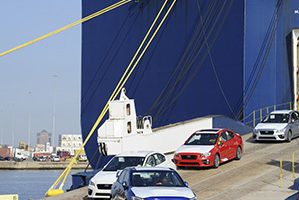 The growing port of Baltimore now offers five vehicle-handling terminals, including Masonville, Fairfield, Atlantic, Chesapeake and Pasha’s recently opened Sparrows Point
The growing port of Baltimore now offers five vehicle-handling terminals, including Masonville, Fairfield, Atlantic, Chesapeake and Pasha’s recently opened Sparrows PointThat support from the MPA combined with improvements made by OEMs and the terminal processors in terms of tracking, storage and haulaway, means it does not suffer the same issues of congestion that are plaguing Veracruz.
Baltimore’s growth as a vehicle handling port means that there are now five vehicle-handling terminals there. Along with Masonville, Fairfield, Atlantic and Chesapeake terminal, last June Pasha Automotive Services opened a terminal at Sparrows Point, a private port in Baltimore on the site of a former steel mill.
While the facility has yet to handle any imports or exports, Pasha confirms that it is currently storing around 20,000 vehicles from two US-based carmakers. Last year, it announced that the facility would handle FCA vehicles. The terminal has its own purpose-built automotive terminal with rail loading facilities and direct access to CSX and Norfolk Southern railroads. It also has access to deep-water berths.
Elsewhere in the north-east region, the state of Pennsylvania is investing $93m in the port of Philadelphia’s finished vehicle terminal to more than double annual import capacity there to 350,000 vehicles, mainly for its customer Glovis America, which manages Hyundai and Kia imports.
Florida risingSouth-east ports in the US saw modest declines in 2016, though some ports did see an increase in volume from sources including Mexico. Jacksonville port (Jaxport) saw a 12% increase in imports, driven by trade with Veracruz, its top port of origin for imported vehicles.
“Mexico continues to be a strong and growing origin for vehicles coming into Jacksonville,” confirms a spokesperson for the port.
Jaxport may be something of an exception in terms of ports reporting very high shipping trade with Mexico. One piece of evidence that the Mexican short-sea rush has yet to arrive is that a clutch of ports along Florida’s east and Gulf coast that recently opened vehicle terminals, partly in expectations of capturing volume from Mexico, still have few if any automotive volumes to report.
Nevertheless, growing sales in Florida and the wider region, along with a strong US dollar, are pushing imports higher this year at Jaxport, added the spokesperson, who says they are up 15% in the first quarter of the year compared to 2016.
[mpu_ad]In response to import demand, Jaxport is expanding its Dames Point Maritime Terminal, which currently handles vehicles along with containers and bulk aggregates. It expects to complete the terminal before the end of 2017, which will strengthen Dames Point’s position as Jaxport’s third car handling facility alongside Blount Island and Talleyrand marine terminals.
That investment follows the opening of a new 11-hectare terminal at the Blount Island Marine Terminal in November last year by Horizon Terminal Services (HTS), the port terminal arm of Höegh Autoliners. Per Folkesson, president of HTS, says Jacksonville had the potential to grow its automotive footprint significantly because of its strategic location and infrastructure.
The strong dollar has hurt exports, however. Along with some other economic problems in the key overseas markets to which Jaxport sends cars, including the Middle East, exports dropped by 30% in 2016 compared to 2015.
Growing a Georgia peachBy contrast, just to the north of Jacksonville, in Brunswick, Georgia, imports are down by around 14% at the Colonel’s Island terminal, the second year of decline from a high of around 539,340 in 2014. Brunswick is part of the Georgia Ports Authority (GPA) which also runs operations at its sister port at Savannah. Combined, the two car terminals handled more than 631,710 vehicles in 2016.
Brunswick’s Colonel’s Island terminal processed more than 440,000 vehicle imports last year, mainly from South Korea for Hyundai Motor and from Europe for Mercedes-Benz. Savannah’s main business is in its exports, which last year were just below 38,200 units.
Despite the drop in imports, lower vehicle sales in the US and a build-up of inventory are affecting capacity at GPA ports. Carmakers and the terminal operators at the ports are looking for places to process and park vehicles. In response, GPA says it will have 88 hectares of additional paving for vehicle processing finished by the end of this year at the Colonel’s Island terminal, bringing its total to 266 hectares of dedicated space. The US Corps of Engineers has also permitted a further 192 hectares for development.
"If one port is backed up, it affects US, Mexico and non-continental ports, considering most vessels travel in circles. Most information to the ports comes from the vessel companies and some from OEMs or other transportation providers." - Charles Franklin, American Honda
Vehicle handling this year is expected to hit around 615,000 units but medium-term forecasts from the GPA put the number of vehicles at the port by 2021 at 712,660.
The port of Virginia’s Newport News Marine Terminal has also improved processing thanks to an amendment to terminal policy that allows vehicles into the terminal without having to be cleared by customs. Clearance is still needed prior to vessel loading but the terminal operator expects to see increased volumes this year of about 30%, though it was unable to provide any figures for 2016 (it handled around 18,000 vehicles in 2015).
Other notable improvements at Newport News have been the recent clearance of triple-deck autorack rail wagons at the terminal and the port is looking at further updating rail solutions to make them more fitted to vehicle processing as well as installing more suitable warehousing.
Charleston’s ‘X’ factorThe port of Charleston in South Carolina remained steady last year, with 265,000 vehicles handled, led by BMW for vehicle exports, as well as some volume for Daimler.
“Finished vehicle exports are on the rise as a direct result of increased vehicle production by our customers,” says a spokesperson for the South Carolina Ports Authority (SCPA).
While that may seem contradicted by the fact that the port’s export numbers declined slightly in 2016, a percentage of vehicle exports are containerised as semi-knockdown and complete knockdown kits, which are not taken into account in our survey.
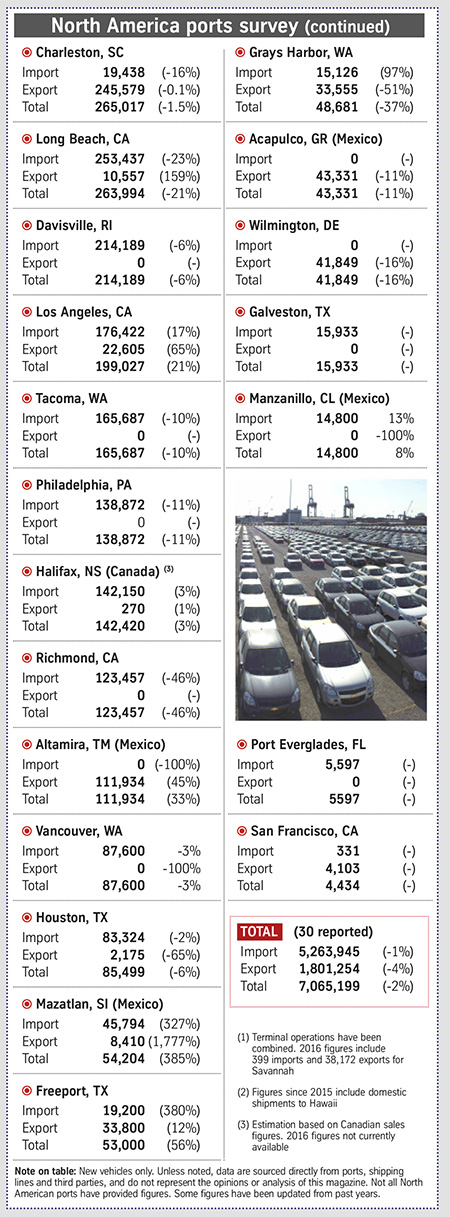 The spokesperson explains that BMW continues to expand production of new and existing models at its manufacturing facility in Spartanburg (roughly 360km from the port) and SCPA currently handles outbound X-Series models across the range to global destinations, notably the UK, Germany and China.
The spokesperson explains that BMW continues to expand production of new and existing models at its manufacturing facility in Spartanburg (roughly 360km from the port) and SCPA currently handles outbound X-Series models across the range to global destinations, notably the UK, Germany and China.
On the import side, Charleston handles BMW 3-Series and other sedans alongside the Mini Cooper, but these are for corporate use, as well as vehicles imported for BMW-sponsored events.
While steady this year, Charleston is looking to benefit from greater volumes by 2019, which by then could mean anything from an additional 60,000-100,000 vehicles a year. That would be the result of further expansion in Spartanburg for BMW, while Volvo Cars is also opening a $500m production facility in nearby Charleston. Starting in 2019, the plant, which will produce the S60 sedan, is expected to have an annual production capacity of 100,000 cars, and may include exports. Mercedes-Benz is also moving to full assembly of [sta_anchor id="5"]its Sprinter at a new facility, which is also in Charleston.
“Both companies are SCPA customers that will further drive automotive-related volume gains for SPCA,” says the spokesperson.
Gulf coast – a pocket of growthWhile the overall US market may be slowing, there are pockets of growth for ports. For example, more OEMs are interested in US Gulf ports in Texas – notably Houston, Freeport and Galveston – where combined vehicle handling increased 23% in 2016 to almost 154,432 units, with a 33% rise in imports.
In Freeport, home of a new terminal managed by Höegh’s HTS, imports from South Korea quadrupled. General Motors’ exports from Freeport to the Middle East remain its strongest business, although these have declined following disruption in Middle Eastern markets.
According to HTS’s Per Folkesson, Freeport is investing in new rail infrastructure to handle trains carrying finished vehicles (and container cargo). It is also building secure and paved yards for receiving, delivering and storing vehicles. HTS will add a new terminal management system to enhance visibility for OEM customers.
The port is also expecting growth in handling inbound volumes from Mexico, with a jump forecast for 2018. Both the port and HTS are making significant investments to support the increase in these inbound volumes.
The port of Houston, a major import centre for the Volkswagen Group, including for rail shipments from Mexico, has also begun converting its Bayport terminal from a failed cruise liner facility into a car-handling terminal. Auto Warehousing Company (AWC) took over the terminal at the end of last year as part of a five-year lease of 15 hectares of land there and started using it to import vehicles from Fiat Chrysler Automobiles. The terminal is expected to import 36,000 vehicles over the next three years.
At Galveston, WWL VSA opened a $12m vehicle-processing centre (VPC) for BMW. WWL imports and processes vehicles annually for onward distribution to 45 BMW and Mini dealers across Texas, Oklahoma, Louisiana and Arkansas. While the port of Galveston only handled around 16,000 vehicles last year, the new centre has the capacity to process 32,500 vehicles, which could mean a jump in numbers in next year’s results. A spokesperson for the port says vehicle inventory has already shown a marked increase because of the BMW and Mini imports and that it has leased additional space to WWL VSA for overflow capacity.
Further to that, and with a view to attracting new OEM customers, the port is working to find private partners to help develop over 40 hectares of greenfield property, build piers and dredge its ship channel adjacent to the property to create an additional ro-ro terminal, with additional vehicle processing facilities.
Galveston has also started handling imported Hyundai-Kia vehicles, which are moved to Hyundai Glovis’ inland vehicle distribution centre at the former GM plant in Shreveport, Louisiana. That facility, which opened in January this year, is handling Kia vehicles [sta_anchor id="6"]imported from the carmaker’s plant in Monterrey, Mexico. Imports are expected to hit 75,000 units a year or more, another boost for vehicle movements through Galveston, although these would not be handled by the same terminal as WWL’s for BMW.
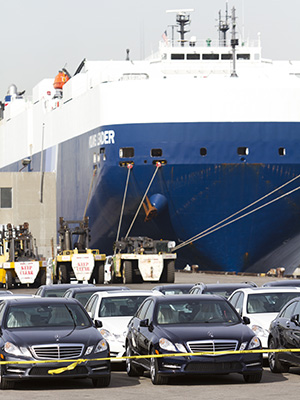 As well as Toyota vehicles, the port of Long Beach saw the opening of a new processing centre by Mercedes-Benz, with further high demand for off-site storage
As well as Toyota vehicles, the port of Long Beach saw the opening of a new processing centre by Mercedes-Benz, with further high demand for off-site storageWest coast – costing the sunOn the west coast, the port of Long Beach saw a big increase in imports last year, led by Toyota. Mercedes-Benz also opened a new processing centre and campus in Long Beach, moving from an older facility in nearby Carson. According to the port, the southern California market remains “very strong” with vehicle sales continuing to grow.
Off-site vehicle processing facilities and storage yards are in high demand at Long Beach and there is intense competition for land near the harbour district between vehicle and container distribution sites as well as e-commerce fulfilment centres.
“To facilitate new customers or expansion of existing facilities, port-adjacent real estate is needed for vehicle processing centres and storage yards,” notes a spokesperson.
A good of example of where that is working is at Mercedes Benz’s vehicle processing centre, 16km inland near Long Beach airport, which opened in 2015 and handles all imports through the port (54,200 last year). According to the carmaker, the facility has the capacity for 70,000 vehicles annually and was built to ensure it had sufficient space and capacity to handle the processing of vehicles.
Long Beach is also going to benefit from a $3.1 billion replacement of the Gerald Desmond Bridge, a critical access route that carries 15% of US waterborne cargo on truck from the port.
“The new bridge will be built with a cable-stayed design and will be high enough to accommodate the newest generation of the most efficient cargo ships,” says the spokesperson for the port. “In addition, the new bridge will be wider and better able to accommodate existing and future traffic volumes.”
Long Beach is also looking at improvements to on-dock rail capacity with the Pier B Rail Yard project. The proposal is to reconfigure, expand and enhance the existing Pier B rail facility located along Anaheim Street and the 710 Freeway to support more efficient use of on-dock rail at the port’s shipping terminals, which will, in turn, ease roadway traffic congestion and improve air quality.
At the nearby port of Los Angeles, imports have grown to almost 176,500 Nissan and Infiniti models, which are managed by WWL. The majority of vehicles come into the port from Japan and South Korea.
As with Long Beach, there are space constraints and the port is making efforts to invest in new supporting facilities. That follows the increase the port made in the availability of rail storage tracks near the WWL facility around a year and half ago. But as Marcel van Dijk at the port makes plain, space constraints look set to hold back Los Angeles for now from further expansion.
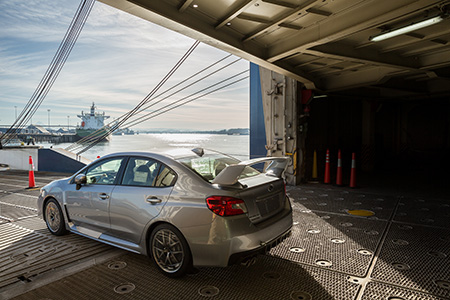 The port of Vancouver, Washington, has been buoyed by strong Subaru sales
The port of Vancouver, Washington, has been buoyed by strong Subaru salesMore space in the north-westThe US port of Vancouver, in the state of Washington, has maintained a steady import business, slightly down on 2015, supported mainly by strong Subaru sales in the US, according to Steve Mickelson, sales director at the port.
“Subaru is the only finished vehicle importer [here],” says Mickelson. “A recent lease extension in 2015 means Subaru will remain with the port until 2030.”
Vancouver, US, is not seeing any capacity problems because it has developed Subaru’s facility with growth in mind, adds Mickelson. The port expects to handle 80,000-90,000 Subaru vehicles this year and has around 16 hectares of space on the south side of Terminal 5 that could be developed into an import/export vehicle handling facility.
“Further growth options within Columbia Gateway would allow for up to 142 hectares of expansion of heavy industrial property adjacent to Terminal 5,” adds Mickelson. “This future marine terminal will be rail-served and is planned for handling cargoes such as automobiles and bulk commodities.”
Vancouver, US, is also making significant investment in rail, and currently constructing 6,705 metres of new track to improve the overall efficiency of the port's internal rail system to support its business with Subaru.
“This project is part of the West Vancouver Freight Access project (WVFA),” explains Mickelson. “The WVFA, a decade-long initiative costing $250m, will more than triple the port’s rail capacity, reducing delays in rail traffic by as much as 40%, giving tenants and customers substantial room to grow.”
The project is expected to be finished by early 2018.
Also in Washington, the port of Tacoma saw a larger decrease in imports last year, dropping nearly 10% to 165,687 units. However, according to a spokesperson for the Northwest Seaport Alliance (NWSA), which manages port operations at Tacoma and Seattle, volume has remained relatively strong despite a shift in vehicle assembly from Asia to Mexico. This year, the port anticipates volumes will decline slightly again to 160,000 units, and perhaps further over the coming years.
Partly as a result, the port has experienced rising inventories and increased dwell time, necessitating temporary overflow locations. However, the spokesperson confirms that NWSA has more than 65 hectares of temporary overflow property on top of its 67-hectare vehicle processing facility.
"[Mexico] has become an increasingly important component of many of the OEMs’ global production platforms, serving markets throughout the world.This is another reason why port infrastructure needs improvement, as while rail service may carry the majority of the Nafta volumes, more global export volumes require deep-sea ocean services with robust port capability." - Flavio Batista, WWL
Over the long-term, imports should recover. “We anticipate a lull in vehicle receipts due to a slowing of the economy in 2019-2020, however we expect volume to rebound to meet or exceed 175,000 units in five years,” says the spokesperson.
While Tacoma’s core market is imports from Japan and South Korea, it sees Mexican short-sea as well as European imports as potential areas of growth. The port is also looking at the potential to develop its export trade to Asia.
Recently, the port has also installed new lamps in the vehicle-handling facility with LED lighting that provides better illumination but at a lower cost.
In Oregon, growth has been stronger at the port of Portland both for imports and exports, with volumes up more than 10% to 291,240 vehicles last year. The port’s core volume is imports, handled by terminal operators AWC as well as Toyota. But it has captured significant export business, including for Ford. According to a spokesperson, exports this year could reach 100,000 units.
The port, along with its tenant port processor AWC, have been granted a ‘ConnectOregon’ grant by the Oregon Department of Transport to fund part of a $7m expansion of vehicle handling facilities at the Rivergate Industrial District (near Terminal 6). The plans call for AWC to develop a new 7.5-hectare storage and staging yard to support the continued growth of vehicle exports from the port.
[sta_anchor id="7"]Such investment demonstrates that there is still growth and expectation in the north-west (whose ports could also benefit from Ford’s China imports) as there is across much of the port network. Growth may be slower, but port trade remains as dynamic as ever.
Gareth Tredway, Robin Meczes and Christopher Ludwig contributed to this report
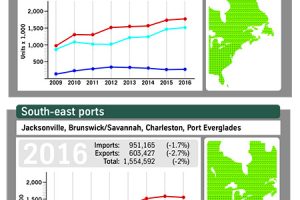 North-east and south-east – click to enlarge
North-east and south-east – click to enlarge North-west and south-west – click to enlarge
North-west and south-west – click to enlarge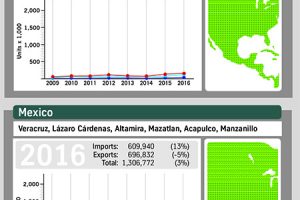 US Gulf and Mexico – click to enlarge
US Gulf and Mexico – click to enlarge
























![Global[1]](https://d3n5uof8vony13.cloudfront.net/Pictures/web/a/d/s/global1_726550.svgz)









